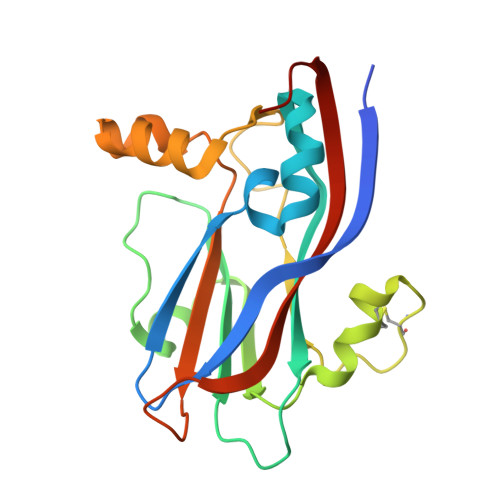T=1 capsid structures of Sesbania mosaic virus coat protein mutants: determinants of T=3 and T=1 capsid assembly
Sangita, V., Lokesh, G.L., Satheshkumar, P.S., Vijay, C.S., Saravanan, V., Savithri, H.S., Murthy, M.R.(2004) J Mol Biology 342: 987-999
- PubMed: 15342251
- DOI: https://doi.org/10.1016/j.jmb.2004.07.003
- Primary Citation of Related Structures:
1VAK, 1VB2, 1VB4 - PubMed Abstract:
Sesbania mosaic virus particles consist of 180 coat protein subunits of 29kDa organized on a T=3 icosahedral lattice. N-terminal deletion mutants of coat protein that lack 36 (CP-NDelta36) and 65 (CP-NDelta65) residues from the N terminus, when expressed in Escherichia coli, produced similar T=1 capsids of approximate diameter 20nm. In contrast to the wild-type particles, these contain only 60 copies of the truncated protein subunits (T=1). CP-NDelta65 lacks the "beta-annulus" believed to be responsible for the error-free assembly of T=3 particles. Though the CP-NDelta36 mutant has the beta-annulus segment, it does not form a T=3 capsid, presumably because it lacks an arginine-rich motif found close to the amino terminus. Both CP-NDelta36 and CP-NDelta65 T=1 capsids retain many key features of the T=3 quaternary structure. Calcium binding geometries at the coat protein interfaces in these two particles are also nearly identical. When the conserved aspartate residues that coordinate the calcium, D146 and D149 in the CP-NDelta65, were mutated to asparagine (CP-NDelta65-D146N-D149N), the subunits assembled into T=1 particles but failed to bind calcium ions. The structure of this mutant revealed particles that were slightly expanded. The analysis of the structures of these mutant capsids suggests that although calcium binding contributes substantially to the stability of T=1 particles, it is not mandatory for their assembly. In contrast, the presence of a large fraction of the amino-terminal arm including sequences that precede the beta-annulus and the conserved D149 appear to be indispensable for the error-free assembly of T=3 particles.
- Molecular Biophysics Unit, Indian Institute of Science, Bangalore 560012, India.
Organizational Affiliation:
















